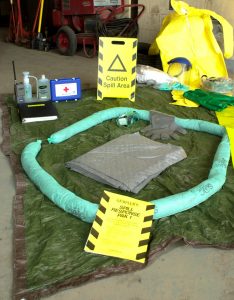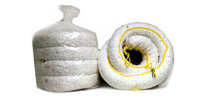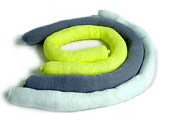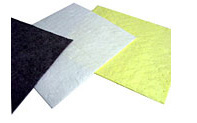 Sorbents are materials used to recover liquids (leaks, drips, spills, etc.). Synthetic sorbents are made of polypropylene – a type of plastic – and are designed to adsorb liquids onto their surfaces, while more basic sorbents like rags, corn cobs, recycled cellulose, vermiculite, or clay actually absorb the liquids into the material itself.
Sorbents are materials used to recover liquids (leaks, drips, spills, etc.). Synthetic sorbents are made of polypropylene – a type of plastic – and are designed to adsorb liquids onto their surfaces, while more basic sorbents like rags, corn cobs, recycled cellulose, vermiculite, or clay actually absorb the liquids into the material itself.
Polypropylene is a petroleum-based product and will naturally repel water while adsorbing any oil or oil-based liquids. Polypropylene products can absorb Water-based spills after they have been treated with a surfactant. Often sorbents are color-coded to help the user select the correct one.
Consider how to dispose of the sorbents prior to purchasing them. If you plan to apply any spilled material that has been absorbed, it must be easily handled for dispersal at or below the labeled rate to a labeled site, which has not already received the maximum rate allowed. If you select a material, like a pad, that cannot be applied, have a plan for how to dispose of the material (state-sponsored clean-sweep hazardous waste collection or private hazardous waste contractor). All materials for disposal require proper identification of the contents (product name, active ingredient, approximate amount).
There are three general types of sorbents.
- Universal sorbents. Will absorb any liquid, including aggressive liquids, such as acids and bases, and are flexible enough to soak up cleaners, water-based fluids, alcohol, and gasoline. Universal sorbents may be made from polypropylene treated with a surfactant or expanded silicates.
- Petroleum sorbents. These are designed to absorb oil or other petroleum-based liquids. They will not absorb any water-based liquids. These sorbents are made of polypropylene or treated cellulose.
- Maintenance sorbents. These are designed to absorb non-aggressive liquids found in industrial and business operations. Some are made of recycled cotton, wool, paper, or corn cobs. There are also some made of polypropylene.
Forms of Sorbents
- Booms, socks, and mini booms can be placed around a spill or machine to keep the liquid from moving.
- Pillows are good for absorbing large spills of liquids. They may also be used in maintenance mode for recurring leaks from valves or pipes.
- Pads and rolls are used to catch drips and leaks as they occur. These can be used in high-traffic aisles or next to machines. Pads can be laid under machines or valves.
- Loose sorbents are granules formulated to absorb liquids when poured on the spill. Loose sorbents are typically used on small liquid spills.
ABSORBENT: Booms
 Booms are available in 5″ and 8″ diameters and come in 10 foot or 20-foot lengths. Booms can be snapped together for use on water or when extra length is needed. They are also material-specific and are used to stop and absorb large spills.
Booms are available in 5″ and 8″ diameters and come in 10 foot or 20-foot lengths. Booms can be snapped together for use on water or when extra length is needed. They are also material-specific and are used to stop and absorb large spills.
ABSORBENT: Socks
 Socks are manufactured with a highly absorbent material covered with a strong polyester sleeve. Placed around a spill, socks are used to stop the spread of the spill.
Socks are manufactured with a highly absorbent material covered with a strong polyester sleeve. Placed around a spill, socks are used to stop the spread of the spill.
ABSORBENT: Pads
 Used to block drains in an emergency. This product will adhere to oily and dirty tanks and drums to plug and dike a spill.
Used to block drains in an emergency. This product will adhere to oily and dirty tanks and drums to plug and dike a spill.
Sorbent Capacity
When purchasing sorbent, consider the ratio of needed absorbent to the volume or weight of spilled material. Sorbent packaging lists the holding capacity, such as the weight it absorbs in relation to itself, for example, “Absorbs 10 times its weight.” The capacity may be listed as the amount of liquid absorbed, for example, “Absorbs 6 gallons.” Assessing a sorbent’s capacity by the number of gallons it will absorb is probably the most accurate way to judge its capacity. As an example, a polypropylene boom four feet long and three inches in diameter will absorb about 1 to 1 1/4 gallons of liquid. A polypropylene pad 16″ x 20″ that is 3/16″ thick will absorb almost 32 fluid ounces of liquid.
Photos: Penn State University Pesticide Safety Education Program
Initial content compiled by Ron Gardner
